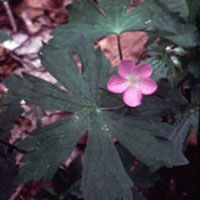Cranesbill
Uses
Parts Used & Where Grown
Cranesbill originated in North America and is sometimes grown ornamentally in a variety of flower colors. The root is primarily used in herbal medicine, but the above-ground part of the plant has also been used traditionally by herbalists.
Our proprietary “Star-Rating” system was developed to help you easily understand the amount of scientific support behind each supplement in relation to a specific health condition. While there is no way to predict whether a vitamin, mineral, or herb will successfully treat or prevent associated health conditions, our unique ratings tell you how well these supplements are understood by the medical community, and whether studies have found them to be effective for other people.
For over a decade, our team has combed through thousands of research articles published in reputable journals. To help you make educated decisions, and to better understand controversial or confusing supplements, our medical experts have digested the science into these three easy-to-follow ratings. We hope this provides you with a helpful resource to make informed decisions towards your health and well-being.
3 Stars Reliable and relatively consistent scientific data showing a substantial health benefit.
2 Stars Contradictory, insufficient, or preliminary studies suggesting a health benefit or minimal health benefit.
1 Star For an herb, supported by traditional use but minimal or no scientific evidence. For a supplement, little scientific support.
This supplement has been used in connection with the following health conditions:
| Used for | Why |
|---|---|
|
1 Star
Canker Sores
Refer to label instructions
|
Cranesbill is an astringent herb that can be used as a mouth rinse to soothe the pain of canker sores. The herb contains tannins that can bind up fluids and possibly relieve inflammation.
Historically, herbs known as astringents have been used to soothe the pain of canker sores. These herbs usually contain tannins that can bind up fluids and possibly relieve inflammation. They are used as a mouth rinse and then are spit out. None of these herbs has been studied in modern times. Examples of astringent herbs include agrimony, , tormentil, oak, periwinkle, and witch hazel. Witch hazel is approved by the German Commission E for local inflammations of the mouth, presumably a condition that includes canker sores. |
|
1 Star
Crohn’s Disease
Refer to label instructions
|
Doctors sometimes recommend this astringent herb in combination with several other herbs to sooth the digestive tract. Because it contains tannin, it may help decrease diarrhea.
Doctors sometimes use a combination of herbs to soothe inflammation throughout the digestive tract. One formula contains marshmallow, slippery elm, , and several other herbs. Marshmallow and slippery elm are mucilaginous plants that help soothe inflamed tissues. Cranesbill is an astringent. Clinical trials using this combination have not been conducted. Tannin-containing herbs may be helpful to decrease diarrhea during acute flare-ups and have been used for this purpose in traditional medicine. A preliminary trial using isolated tannins in the course of usual drug therapy for Crohn’s disease found them to be more effective for reducing diarrhea than was no additional treatment. Tannin-containing herbs of potential benefit include agrimony (Agrimonia spp.), green tea, oak, witch hazel, and . Use of such herbs should be discontinued before the diarrhea is completely resolved; otherwise the disease may be aggravated. |
|
1 Star
Diarrhea
Refer to label instructions
|
Cranesbill has been used by several North American indigenous tribes to treat diarrhea. The tannins in cranesbill likely account for the anti-diarrheal activity.
has been used by several of the indigenous tribes of North America to treat diarrhea. The tannins in cranesbill likely account for the anti-diarrheal activity—although there has been little scientific research to clarify cranesbill’s constituents and actions. |
|
1 Star
Menorrhagia
Refer to label instructions
|
Astringent herbs such as cranesbill have been traditionally used for heavy menstruation.
Cinnamon has been used historically for the treatment of various menstrual disorders, including heavy menstruation. This is also the case with shepherd’s purse (Capsella bursa-pastoris). Other herbs known as astringents (tannin-containing plants that tend to decrease discharges), such as , periwinkle, witch hazel, and oak, were traditionally used for heavy menstruation. Human trials are lacking, so the usefulness of these herbs is unknown. Black horehound was sometimes used traditionally for heavy periods, though this approach has not been investigated by modern research. |
Traditional Use (May Not Be Supported by Scientific Studies)
The Blackfoot Indians of North America used the root of cranesbill and closely related plants to stop bleeding.1 Cranesbill has also been used by other indigenous tribes of North America to treat diarrhea.
How It Works
How It Works
Cranesbill is high in tannins, which may account for its anti-diarrheal activity.2 Little scientific research exists to clarify cranesbill’s constituents and actions.
How to Use It
A tea can be prepared by boiling 1–2 teaspoons (5–10 grams) of the root for ten to fifteen minutes in 2 cups (500 ml) of water.3 People can drink three (750 ml) or more cups per day. Cranesbill tincture (approximately 1/2 teaspoon or 3 ml) three times per day is also commonly used, although generally in combination with other herbs, for diarrhea. Dried, powdered cranesbill root is sometimes used in an herbal combination to treat Crohn’s disease; however, there are no scientific studies to support this combination.
Interactions
Interactions with Supplements, Foods, & Other Compounds
Interactions with Medicines
Last Review: 05-24-2015

Copyright © 2025 TraceGains, Inc. All rights reserved.
Learn more about TraceGains, the company.
The information presented by TraceGains is for informational purposes only. It is based on scientific studies (human, animal, or in vitro), clinical experience, or traditional usage as cited in each article. The results reported may not necessarily occur in all individuals. For many of the conditions discussed, treatment with prescription or over the counter medication is also available. Consult your doctor, practitioner, and/or pharmacist for any health problem and before using any supplements or before making any changes in prescribed medications. Information expires December 2025.



